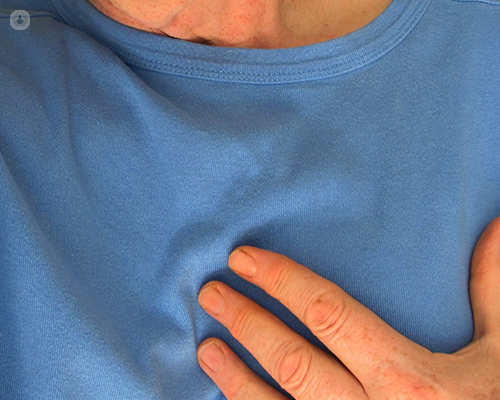What is microvascular angina?
Written in association with:Microvascular angina is a lesser-known form of heart-related chest pain that can have a profound impact on daily life.
Dr Giovanni Luigi De Maria, distinguished consultant interventional cardiologist, explores what microvascular angina is, its symptoms, how it differs from traditional angina, and the latest treatment approaches aimed at managing this condition.

What is microvascular angina?
Microvascular angina is a condition caused by dysfunction in the small blood vessels of the heart, known as the coronary microvasculature. These vessels usually transport blood to the heart muscle, but in people with microvascular angina, the coronary microvasculature constrict and don’t function properly, limiting blood flow to the heart.
The most common symptom of microvascular angina is chest pain, which is often described as a tight, heavy, or squeezing sensation. This pain may radiate to the arms, neck, jaw, or back. Other common symptoms also include shortness of breath and persistent fatigue, even without strenuous activity. These symptoms may come and go and can occur even when at rest.
Microvascular angina is often linked to risk factors such as high blood pressure, diabetes, high cholesterol, and a family history of heart disease. Stress, obesity, and smoking can also increase the likelihood.
Is microvascular angina the same as typical angina?
Typical angina, also known as obstructive or stable angina, is generally caused by atherosclerosis, where plaques of fatty substances build up inside the larger coronary arteries, leading to blockages or narrowing. These blockages restrict blood flow to the heart muscle, resulting in pain during physical activity or emotional stress, which subsides with medications or after surgical procedures to clear the blockages.
In contrast, microvascular angina occurs without visible blockages in the large coronary arteries. Instead, it’s related to dysfunction of the endothelium (the inner lining) in the small blood vessels, which prevents the vessels from dilating as needed. This reduced blood flow may not be easily visible on standard angiograms, as these imaging tests primarily focus on the larger coronary arteries.
How is microvascular angina treated?
Unlike typical angina, microvascular angina can’t be treated with procedures like angioplasty or stenting, as these directly relieve blockages in the larger coronary arteries. Instead, treatment for microvascular angina generally involves medication, lifestyle changes, and addressing risk factors.
Medications commonly prescribed for microvascular angina include beta-blockers and calcium channel blockers, which reduce heart rate and the demand on the heart. Nitrates can help dilate and widen blood vessels, while statins are often prescribed to reduce inflammation. Additionally, aspirin or other antiplatelet medications may be recommended to prevent clot formation.
Lifestyle modifications are also essential in managing microvascular angina. Adopting a heart-healthy diet, engaging in regular physical activity, managing stress, and quitting smoking can significantly improve heart health and alleviate symptoms. For people with hypertension or diabetes, managing these conditions effectively is crucial to reduce the impact on the microvascular system.
In some cases, a cardiac rehabilitation programme can provide structured exercise routines and support for making these lifestyle changes.
Can microvascular angina lead to heart failure or other complications?
Microvascular angina is less likely to cause a heart attack than typical angina, but it can still have significant long-term effects. Over time, reduced blood flow in the small vessels can lead to chronic ischaemia, or insufficient oxygen supply to the heart muscle. This can weaken the heart’s ability to pump blood effectively, increasing the risk of developing heart failure.
In addition, ongoing symptoms of chest pain, shortness of breath, and fatigue can lead to frequent visits to the hospital and interference with daily activities. These factors can contribute to anxiety, depression, and reduced quality of life.
Long-term outcomes for people with microvascular angina vary. Medications, lifestyle adjustments, and regular monitoring can help to prevent symptoms from worsening and reduce the risk of further cardiovascular events. However, the chronic nature of microvascular angina means that symptoms may persist or recur, and ongoing management is required to keep the condition under control.
If you would like to book an appointment with Dr Giovanni Luigi De Maria, head on over to his Top Doctors profile today.


